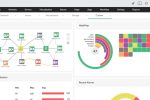By. Priyanka Roy, Enterprise Evangelist, ManageEngine
With all the curveballs recent events have thrown our way, one thing that has become clear is that in order to survive, businesses need to be able to respond to disruptions quickly. While many companies collapsed due to the fallout of the pandemic, the ones that didn’t—the ones that managed to survive or, in fact, thrive—are the ones that were able to think on their feet and connect with their customers. One of the most important elements of building a great customer relationship program is personalization. To remain competitive, organizations need to be responsive and provide a personalized customer experience (CX) that their end users can relate to.
When done right, personalization can yield increased engagement, greater mindshare, and enhanced customer loyalty. The market demands this personalization too, as it makes customers feel like a business understands their needs and values their input. A recent research report published by SmarterHQ found that 72 percent of consumers say that they now only engage with marketing messages tailored to their interests. This goes to show how important it has become for businesses to connect with their customers.
However, it’s important to keep in mind that the success of a personalized CX program depends on how much customers trust the company. To build a truly personalized experience, organizations need access to data that they can use to gather actionable insights. The trust that organizations will need to establish then hinges on their ability to exhibit fair practices, accountability, and transparency when it comes to data processing.
In Indonesia, this is becoming a pressing concern for end users and it is driving change in the way legislative bodies look at data privacy. This is aided by growing support of observance days such as Data Privacy Day, celebrated annually on 28th January.
Currently, Indonesia does not have an overarching personal data protection law but regulations on personal data protection are scattered within several sectoral laws and regulations. This is changing with the Personal Data Protection (PDP) Bill which is being finalised by the Indonesian House of Representatives (DPR). According to PwC, the PDP Bill regulates a wide range of matters, from types of personal data, stakeholders’ rights and obligations, processing and transferring, data protection officer appointments, dispute resolutions, and even administrative and criminal sanctions. The scope of the PDP Bill is leaning towards that of the General Data Protection Regulation 2016/679 (GDPR) issued by European Parliament and Council of the European Union.
A matter of values
Given the dynamism of consumer behaviour patterns and the unpredictability of market conditions, customer relationships are forged on one-on-one engagement. In order to build that reliable connection with consumers, organizations need to tap into customer preferences—how they act, feel, and behave. This intelligence is gathered from user data collected at various stages of the customer journey.
If consent is sought in the appropriate manner, consumers are usually okay with their data being collected and processed as long as they benefit from it. The SmarterHQ report also found that 90 percent of consumers are willing to share behavioral data if it results in a cheaper, easier shopping experience.
Now, what constitutes value will obviously differ slightly from customer to customer. Here’s where the real intelligence comes in. How do organizations leverage user data in a way that allows them to deliver maximum value to consumers? Success in personalization starts with ensuring that the organization has data that matches its business goals. This could be biographical information, data derived from how consumers engage with services or offerings, web cookie data, or survey findings—and it all must come from reliable sources.
So, this is where transparency in consent and communication preference management practices comes in. While consumers understand the trade-off involved in sharing their data with companies in exchange for value, the relationship can quickly turn sour if data is utilized in a manner that the consumer wasn’t explicitly made aware of or did not consent to. Over the last two years, personal data of millions of consumers derived from e-commerce marketplaces in Indonesia were allegedly sold online.
Where data privacy and personalization intersect
Today there is heightened consumer awareness regarding how data is collected, used, and shared. Rather than looking at this shift in awareness as a deterrent, businesses need to realize that this provides a new opportunity to enhance their relationship with their customers. Consumers are more willing to share their data when they implicitly trust that, in addition to the value they’ll receive, their data will also be used only for purposes clearly stated by the company.
“Consent data”, which is information collected through an honest and transparent process, should form the cornerstone of an organization’s personalization strategy. This data needs to be obtained directly from the end user, who’s made fully aware of the intended use and potential benefits of the data. The end user needs to be informed about what data is being collected, why it is being collected, how long it will be stored or utilized, and who it will be shared with. Additionally, the practice of keeping the customer informed is not a one-time activity to be carried out at the time of data collection; this needs to be an iterative process wherein the consumer is consistently kept informed throughout the data life cycle.
When organizations use consent data, they not only improve their CX but also drive product innovation and marketing effectiveness. Brands that incorporate this transparency foster a sense of mutual trust, respect, security, and privacy with their clients. Organizations also need to keep in mind that consumer preferences can change over time, so opt-in and opt-out options should be provided at different checkpoints to give consumers control over their personal data throughout the customer journey. Lastly, businesses should incorporate the principle of privacy by design into all their business practices. This enables organizations to anticipate privacy issues and avoid them.
The bottom line is that privacy and personalization can definitely coexist, provided organizations are willing to be fair and transparent about their practices. Consumers have the power to decide whether the privacy-benefit trade-off is worth it and, if it’s not, take their business elsewhere. With user data privacy regulations such as the new PDP bill and GDPR on the rise, businesses will either need to ensure that they are utilizing data judiciously or risk falling behind.




















